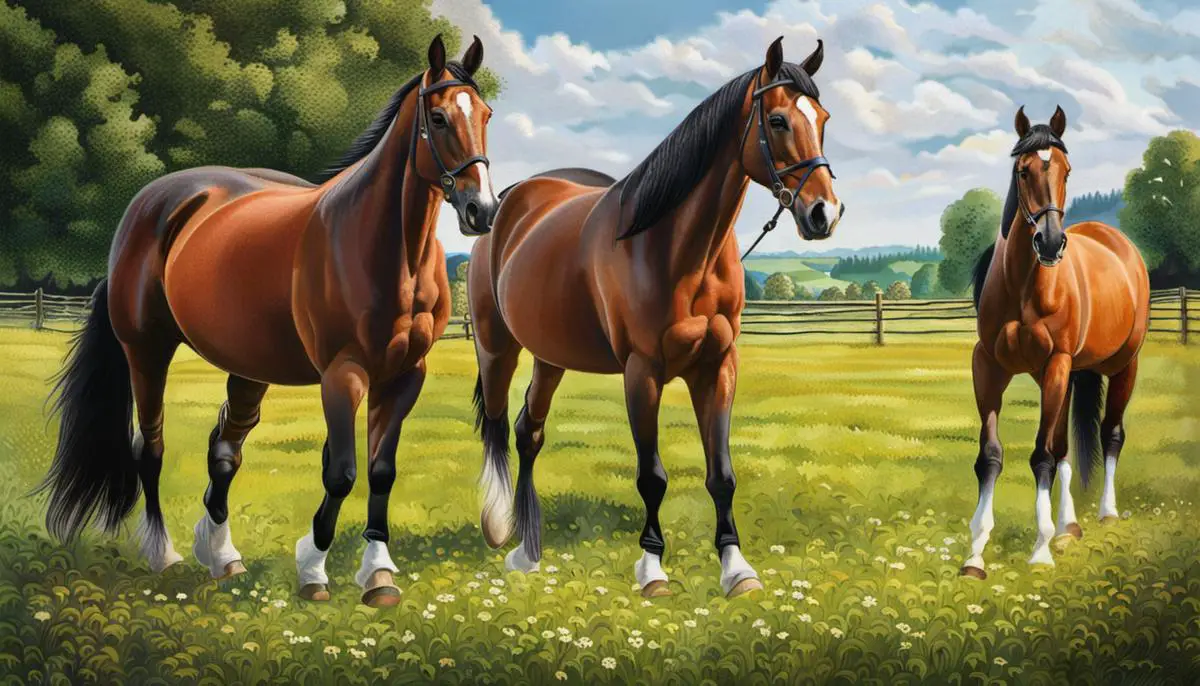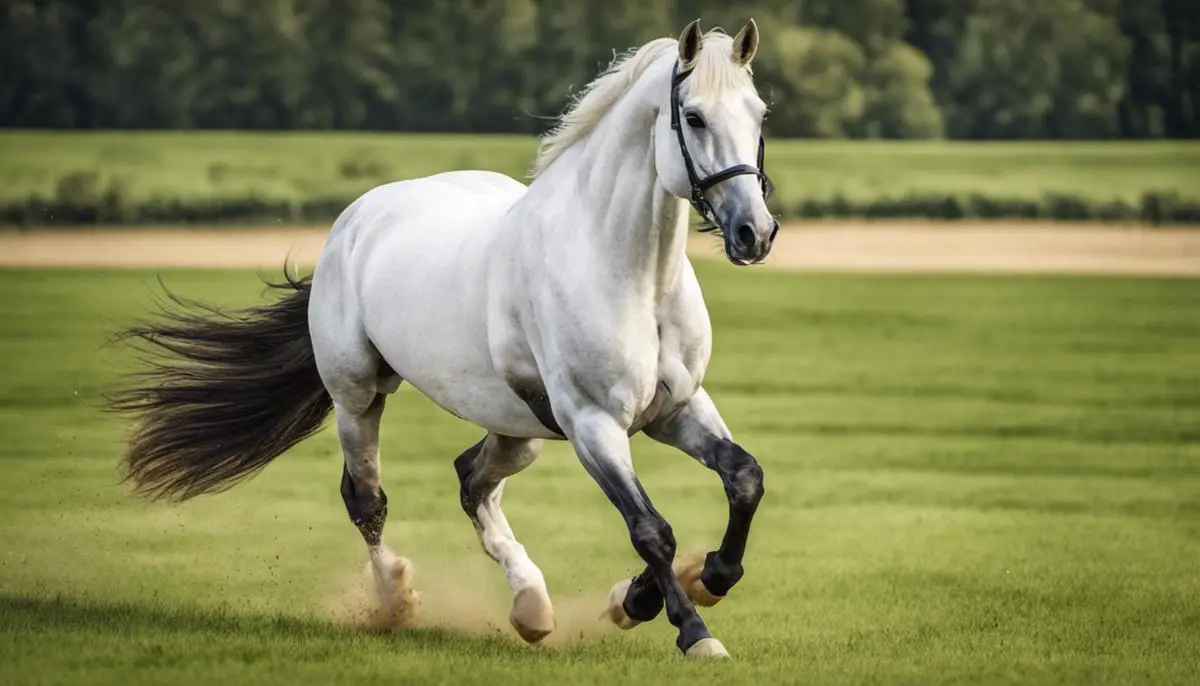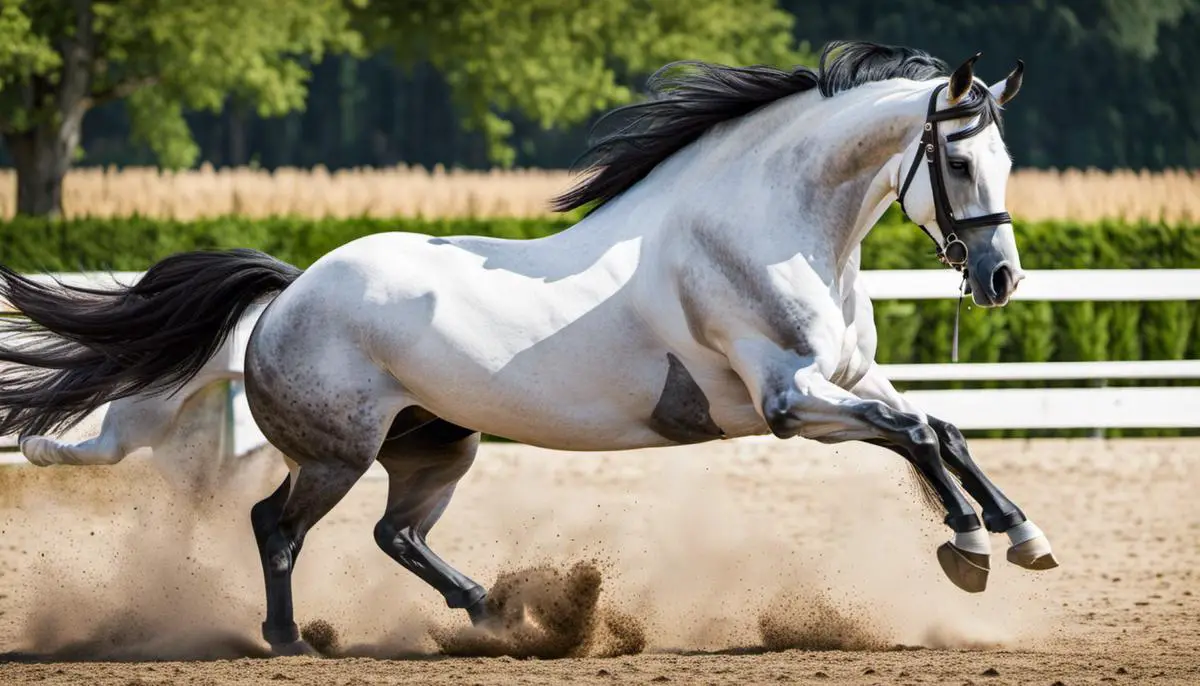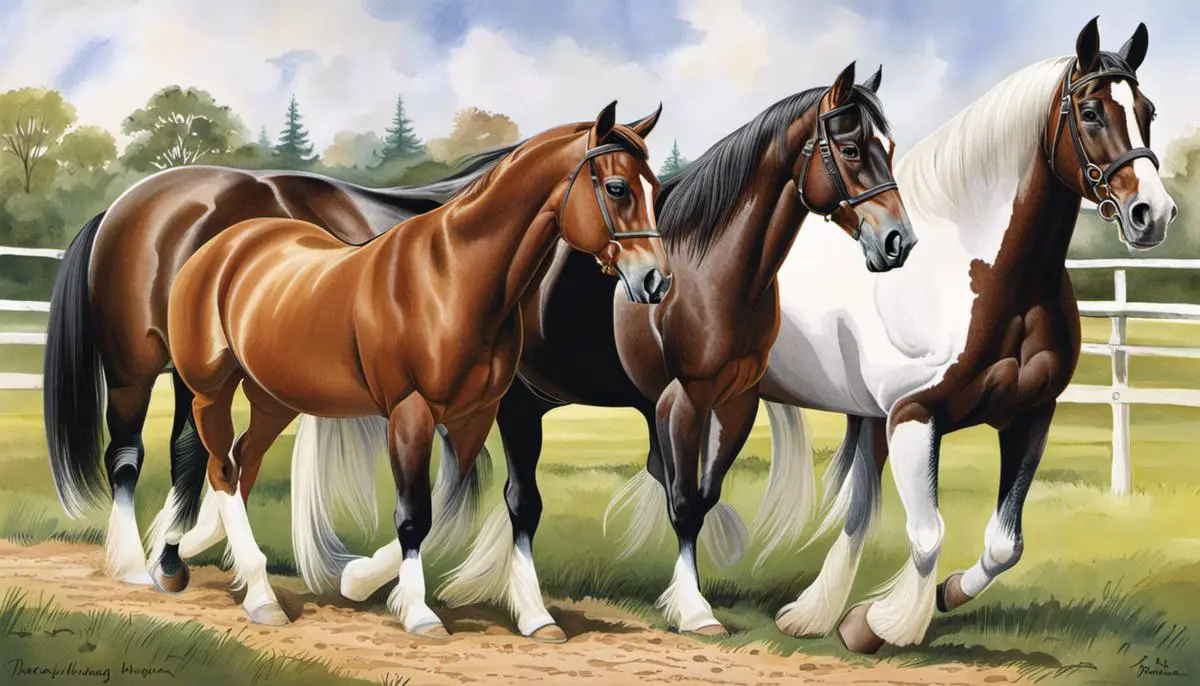Immerse yourself in the fascinating world of Bavarian Warmblood horses, an exceptional breed rooted deeply in history and characterized by its immense versatility, breathtaking beauty, and endearing temperament. Originating from the heart of Europe, the Bavarian Warmblood boasts an intriguing past that intertwines with human history, enhancing our understanding of humanity’s timeless bond with these magnificent creatures. Moreover, analyzing their distinct physical characteristics will shine a light on the stark uniqueness of this breed. With great care, Bavarian Warmbloods not only thrive but demonstrate remarkable accomplishments in various equestrian sports, serving as reflections of their robust health and apt handling.
Table of Contents (Horspedia)
Breed History of Bavarian Warmblood
Origins of Bavarian Warmblood
The Bavarian Warmblood hails from the state of Bavaria in southern Germany, a region with an extensive history of horse breeding dating back to the Middle Ages. However, the specific Bavarian Warmblood breed was developed only in the 20th century, combining the bloodlines of various other types of German and European Warmblood. Though these horses possess characteristics typical of the Warmbloom category—including robustness, versatility, and suitability for equestrian sports—they distinguish themselves through their Bavarian origins, which shape their breeding and registration to this day.
Development of Bavarian Warmblood Breed
The foundation of the Bavarian Warmblood breed lies in the late 18th century when Thoroughbred and Arabian horses were crossbred with native Bavarian mare stock to enhance their agility, speed, and endurance. This breed was initially called the Rottaler. Later, in the mid-20th century, other warmblood breeds such as the Hanoverian and Trakehner were integrated into the breeding program to imbue the breed with the characteristics that are sought after in modern sport horses.
Purpose of Breeding Bavarian Warmblood
The essential motive behind the development of the Bavarian Warmblood was to create a breed of horse suitable for various sports events. Bavarian Warmbloods were bred keeping the needs of modern equestrian sports in mind. These horses are now popular in events such as dressage, showjumping, and three-day eventing.
Role of Bavarian Warmblood in History
The Bavarian Warmblood has traditionally been a versatile horse during its history. Prior to their evolution into sport horses, they were often used as carriage horses and farm animals. Their strength and endurance made them an excellent choice for hard labor. Since their transformation into modern sport horses, they have made their mark in national and international equestrian competitions. Equipped with dynamic movement, courage, and a balanced temperament, Bavarian Warmbloods often perform well at the highest levels of competition.
Introduction to the Bavarian Warmblood Breeding Society
Established in 1963, the Bavarian Warmblood breeding society came into being to consolidate local horse breeding efforts within a more organized and focused framework. In contemporary times, the collective bredding strategy for Bavarian Warmbloods has been supervised by the Bavarian State Stud in Schwaiganger. The stud farm is responsible for ensuring that the breed’s standards and quality are meticulously upheld.

Physical Characteristics and Traits
Exploring the Physical Characteristics of the Bavarian Warmblood
Bavarian Warmbloods, a breed originating from Southern Germany’s Bavarian region, are highly versatile horses that combine an exquisite structure with strength and agility. This breed encapsulates the best qualities of its primary ancestors, the Thoroughbred, Trakehner, and Hanoverian breeds.
With a robust, well-muscled body, the Bavarian Warmblood is noted for its commanding physique and overall sturdy appearance. The breed’s head commonly displays a straight or slightly convex profile, with large, expressive eyes and neatly-set ears. A smooth, long, and arched neck leads down to distinct withers, a deep, broad chest, and a strong back. Bavarian Warmbloods boast strong limbs complemented by hard hooves, making them apt for sporting activities such as dressage, eventing, and jumping.
The coat’s color varies considerably amongst Bavarian Warmbloods. The most typical color schemes are bay, chestnut, black, and gray, but all solid colors are accepted. White markings, apart from on the head and legs, are relatively rare.
The height and weight of these horses can vary based on lineage, but the standard height hovers around 16 to 17 hands (64 to 68 inches). Their weight, typically falls between 1,100 to 1,300 pounds, although individual variations are ordinary.
Temperament and Behavior of the Bavarian Warmblood
Renowned not just for their physical attributes, Bavarian Warmblood horses are also cherished for their temperament and behavior patterns. They possess a positive and willing nature that transforms them into fast learners and makes them highly trainable. Additionally, their inherited Thoroughbred and Hanoverian traits render them good-natured and even-tempered, which make them highly adaptable to a range of equestrian activities.
Their easy-going demeanor, coupled with their natural bravery, makes them very suitable for working with riders of varying skill levels. Due to their steady, calm, and obedient temperament, Bavarian Warmbloods are often used in therapeutic riding programs.
In addition to their gentle nature, Bavarian Warmbloods are also known for their impressive stamina and endurance, qualities that serve them well in demanding disciplines such as show jumping and eventing.
Overview
Recognized for their impressive strength, diverse aesthetic shades, and lively yet well-controlled demeanor, Bavarian Warmbloods are true all-rounders, mastering various equestrian pursuits. Their multifaceted abilities and admirable characteristics have not only made them a sought-after breed but also underlined their uniqueness in the realm of horse breeds.

Health and Care of Bavarian Warmblood
Health Profile of Bavarian Warmblood
Generally speaking, the Bavarian Warmbloods are celebrated for their solid health and vigor, often living longer than many other breeds. Known for their speed, endurance, and strength, they are not easily susceptible to many common horse diseases. Nonetheless, it is crucial that these horses are provided with consistent and thorough veterinary care and require regular check-ups by a competent equine vet to maintain their overall wellness.
Common Health Issues
Bavarian Warmbloods are vulnerable to the same health issues that affect most horse breeds. These can include laminitis, a painful inflammation of the tissues that bond the hoof structures to the foot, and colic, a common yet potentially life-threatening digestive disorder. They may also be predisposed to developing certain orthopedic diseases and conditions like osteochondrosis due to their size and athleticism. Regular veterinary examinations, prompt medical attention to any health issues, and conscientious care can help prevent or manage these issues.
Life Expectancy
Bavarian Warmbloods have a life expectancy of 25 to 30 years, though many factors can affect this. Good health, ample exercise, and a well-balanced diet can ensure a long life, while health problems or injuries can shorten it. Much of a Bavarian Warmblood’s lifespan depends on the quality of care it receives throughout its life.
Dietary Requirements
A balanced diet is vital to the health and performance of a Bavarian Warmblood. Generally speaking, these horses need a high-quality forage-based diet, with the addition of concentrates and supplements as necessary, particularly during periods of intense training or competition. It is also essential to provide plenty of clean, fresh water. A horse’s specific dietary needs can vary based on factors like age, weight, activity level, health status, and the climate in which it lives. A vet or an equine nutritionist can provide specific guidance.
Grooming and Hygiene
Regular grooming is not only necessary for keeping a Bavarian Warmblood looking its best, but also for maintaining its overall health. Grooming allows the opportunity to check for injuries, skin conditions, or signs of disease. Regular hoof care, including cleaning and trimming, can help prevent problems like laminitis, while dental care is important for maintaining a horse’s ability to eat properly. Regular bathing, checking and taking care of the horse’s ears, eyes, and coat will ensure optimal health.
Physical Exercise
Bavarian Warmbloods are athletic horses, designed for high-performance sports like dressage, show jumping, and eventing. Therefore, they require a significant amount of exercise to maintain their health and condition. On average, they should have at least one to two hours of moderate exercise per day, though this may increase during times of training or competition. This doesn’t always mean ridden exercise; lunging, turnout in a large yard or field, and even horse-play with other horses can all contribute to a horse’s daily exercise needs.
Responsible Ownership
Becoming a rightful owner of a Bavarian Warmblood implies dedicating a substantial amount of time and investing copious resources. However, the returns are fulfilling as you accomplish a lively, intrepid partner potentially excellent at equine sports.

Bavarian Warmblood in Equestrian Sports
The Bavarian Warmblood: An Athletic Prodigy in Equestrian Sports
Noted for their power, athleticism, and durability, Bavarian Warmbloods are remarkably adept in numerous facets of equestrian sports. These performance horses have been meticulously bred over many decades and have shown proficiency in high-level dressage, show jumping, and eventing. Despite their versatility across different disciplines, Bavarian Warmbloods particularly shine in dressage and show jumping, attributing to their agility, kinetic energy, muscular build, and indomitable spirit.
Physical Attributes and Temperament
Key characteristics of Bavarian Warmbloods include a powerful, well-muscled body, a straight, long-lined profile, and large, compelling eyes, all of which contribute to their athletic abilities. They typically stand between 16 to 17 hands high, which equates to 64 to 68 inches at the withers. They possess a wide, deep chest and a strong back alongside well-defined, solid legs, suitable for handling the force exerted during jumps. This breed demonstrates a graceful action, with the inherent capacity to change speed and maneuver quickly, necessary traits for equestrian sports.
Most Bavarian Warmbloods are recognized for their obedient, reliable, and willing temperament, qualities favored by riders across disciplines. They demonstrate a remarkable trainability and responsiveness to rider’s cues, which make them outstanding competitors in equestrian competitions.
Bavarian Warmbloods in Equestrian Sports
Bavarian Warmbloods have a prominent place in global equestrian sports due to their ability to compete at elite levels. Their role is hard to overlook, given their consistently strong performance across a variety of disciplines. Within dressage, Bavarian Warmbloods often display their effective, yet lightweight, strides and manoeuvrability, coupled with an intense and focused temperament, which is highly valued in this precision-oriented discipline.
In show jumping, the breed’s versatility, keen instincts, and power are put to the test. Bavarian Warmbloods have excelled in numerous National and International events, including the Olympic Games. For example, notable Bavarian Warmblood mare, Goldika, and her rider Ludger Beerbaum represented Germany in the 1992 Barcelona Olympics and successfully clinched a team Gold Medal in show jumping.
Similarly, in eventing—a discipline combining dressage, cross-country, and show jumping—Bavarian Warmbloods showcase their superb stamina, agility, and ability to transition between the different aspects of the sport.
Breeding and Development
The beginnings of the Bavarian Warmblood breed date back to the post-World War II era, when the intention was to create a versatile sports horse that could compete at a world-class level. The breed’s development involved crossbreeding local Bavarian mares with stallions of warmer blood, primarily Trakehners and Thoroughbreds. Over time, more breeds, including Hanoverians and Oldenburgs, were introduced into the breeding program to enhance certain traits. Today, Bavarian Warmbloods have not only lived up to the initial breeding goals, but also outperformed expectations across the globe in the field of equestrian sports.
Thus, Bavarian Warmbloods, endowed with distinct attributes like athleticism, power, obedience, and a competitive spirit, are a prominent choice in equestrian sports. Their achievements in various disciplines, from dressage to show jumping, are a testament to their versatility and superiority.

A dive into the life of the Bavarian Warmblood is an exploration of an exemplary breed that has stood the test of time and continues to be admired globally. These horses, with their captivating physical characteristics and unmistakable traits, embody nobility and elegance, while their health and longevity are a testament to attentive care, as well as their inherent strength. Above all, their prominence in equestrian sports bears witness to the agility and endurance they possess. As we continue to unravel the mysteries behind these equine wonders, the reverence for the Bavarian Warmblood grows, encouraging us to celebrate its existence and nurture its future generations.

